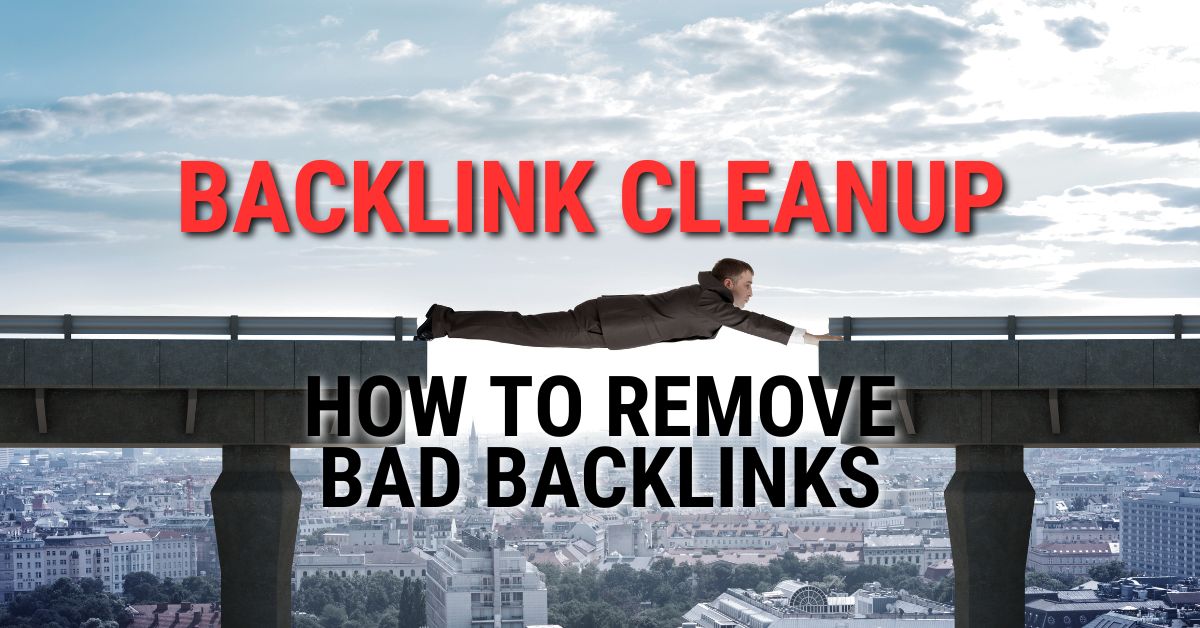If your rankings took a hit and your organic traffic has been trending down, checking your backlink profile for bad backlinks might be a good idea.
Bad (or toxic) backlinks can decrease your SEO performance, pass on Google algorithm penalties, or even be part of a negative SEO campaign.
In this article, I will guide you through the process of identifying, removing, and preventing bad backlinks to ensure your website’s success. From using tools like Google Search Console, Ahrefs, SEMrush, and Majestic to contacting website owners and utilizing Google’s Disavow Tool, I will provide you with the necessary steps to clean up your backlink profile effectively.
Stay tuned to learn how to maintain a healthy backlink profile and boost your website’s ranking.
Key Takeaways:
- Identifying bad backlinks is crucial for maintaining a healthy website. Use tools like Google Search Console, Ahrefs, SEMrush, and Majestic to easily identify them.
- Removing bad backlinks can be achieved by contacting the website owner, disavowing the links, using Google’s disavow tool, and requesting removal from Google.
- To prevent bad backlinks in the future, regularly monitor your backlinks, perform link audits, focus on building high-quality backlinks, and avoid spammy link building tactics.

What Are Bad Backlinks?
Bad backlinks are inbound links to a webpage coming from websites that are considered low quality, irrelevant, or spammy. These links can negatively impact a website’s search engine ranking and online reputation.
Some common types of bad backlinks include links from link farms, which are networks of websites created solely for link building purposes without providing any valuable content to users.
Another example is acquiring paid links from websites that sell links to manipulate search rankings artificially. Backlinks from irrelevant directories that are not related to the website’s niche or industry are considered harmful.
Having such toxic backlinks can lead to severe consequences for a website, such as a drop in search engine rankings, reduced organic traffic, and negative impact on user experience.
Google penalizes websites with bad backlinks through manual actions or algorithmic penalties, further decreasing their visibility in search results and potentially causing long-term damage to their online presence.

How Do Bad Backlinks Affect Your Website?
Bad backlinks can negatively affect your website, impacting its SEO performance and organic traffic and even leading to potential penalties from search engines like Google. These toxic links can also degrade the user experience by directing visitors to irrelevant or spammy content.
When your website accumulates bad backlinks, search engine algorithms may view it as trying to manipulate rankings artificially. This can result in a drop in search engine positions, decreased visibility, and reduced organic traffic.
If search engines detect a high number of spammy or irrelevant backlinks, they may impose penalties such as manual actions or algorithmic filters, severely impacting your website’s overall performance.
Besides, users who click on these harmful backlinks may encounter viruses, malware, or phishing scams, undermining their trust in your site and discouraging them from returning.

How to Identify Bad Backlinks?
Identifying bad backlinks is crucial for maintaining a healthy backlink profile. Various tools such as Google Search Console, Ahrefs, and Moz can be utilized to analyze backlink profiles and detect toxic links that could be harming your website’s SEO.
Google Search Console offers a detailed overview of backlinks pointing to your site, allowing you to identify potentially harmful ones. Ahrefs and Moz provide in-depth analysis, including anchor text distribution and domain authority, helping with pinpointing low-quality links.
Regular backlink audits are essential to monitor the quality of your link profile and take necessary actions to disavow toxic links. The disavow tool, provided by Google, enables webmasters to signal which links should be ignored by the search engine, mitigating the negative impact of bad backlinks on your site’s ranking.

Google Search Console
Google Search Console is a valuable tool provided by Google to help webmasters monitor their website’s presence in Google search results. It can also be used to check for backlinks pointing to your site and identify any potential issues like link spam that may require disavowing.
Within Google Search Console, webmasters can navigate to the ‘Links’ section to access detailed information on their website’s backlinks. This feature allows users to view the total number of backlinks, referring domains, and the most linked content on their site.
Look for a high number of links created in the recent period. Check what kind of keywords they rank for.
If you find backlinks with weird Japanese or Chinese characters, you know you’ve been hit with negative SEO.
GSC offers a ‘Manual Actions’ report that highlights any manual penalties imposed by Google due to link-related violations. This report is crucial in identifying and addressing link spam, unnatural links, or other manipulative tactics that could harm your site’s search rankings.
If webmasters identify toxic backlinks that could potentially harm their website’s SEO performance, they can initiate the process of disavowing these links through Google Search Console.
By uploading a disavow file containing the URLs of unwanted backlinks, webmasters can request Google to ignore these links when evaluating their site’s trustworthiness.

Ahrefs
Ahrefs is a comprehensive SEO tool that offers detailed insights into backlink profiles, domain ratings, and spam scores. This tool allows you to track and analyze your backlink profile to identify and remove toxic or spammy links.
One of the key functionalities of Ahrefs is its ability to provide a deep dive into the quality of backlinks pointing to a website. Here’s how to find bad backlinks with Ahrefs:
- Paste your backlink in Site Explorer.
- Go to Organic keywords.
- You can go either manually or filter spam keywords such as “login,” “sex,” “slots,” “casino,” or anything else that is suspicious or unrelated to your website.
If you find spammy or gibberish keywords, there is a high chance these links pass toxic juice to your site. Get rid of them.
Compile them in a list and create a disavow file – you can do it within the tool.

SEMrush
SEMrush is a popular SEO tool that offers in-depth backlink analysis and helps website owners identify high-quality backlinks that positively impact their SEO efforts. You can gain valuable insights into your backlink profile and make informed decisions for link building.
One of the key features of SEMrush is its capability to differentiate between high-quality and toxic backlinks. This tool uses advanced algorithms to assess the authority and relevance of each backlink, allowing users to prioritize their link-building efforts effectively.
By identifying and focusing on high-quality backlinks, website owners can enhance their search engine rankings and overall online presence.

Majestic
Majestic is a specialized tool for backlink analysis that offers insights into a website’s backlink profile, reputation, and susceptibility to negative SEO tactics. By utilizing Majestic, website owners can uncover potential risks posed by bad backlinks and take proactive measures to safeguard their online reputation.
One of the key features of Majestic is its ability to assess the quality of backlinks by examining various metrics such as Trust Flow and Citation Flow.
These indicators provide a comprehensive view of the link profile’s authority and credibility. You can use these indicators to differentiate between valuable links and harmful ones.
In addition, Majestic’s advanced algorithms can detect patterns associated with negative SEO efforts, helping users to spot malicious activities aimed at manipulating search engine rankings.
How to Remove Bad Backlinks?
Removing bad backlinks is essential to protect your website from potential SEO penalties and improve its overall search visibility. Website owners have several options, including contacting the linking site owners directly, using the disavow tool, or requesting removal assistance from Google.
Taking proactive steps to address bad backlinks promptly is essential for safeguarding your website’s online presence and ensuring its long-term success in search engine rankings.
Contact the Website Owner
When identifying bad backlinks, one proactive approach is to contact the website owner responsible for the linking site and request the removal of the harmful links. By engaging directly with the site owner, you can expedite the process of eliminating toxic backlinks from your website’s profile.
Directly reaching out allows you to explain the situation clearly and make a personal connection with the site owner. Crafting a polite and professional template outreach email can help streamline your communication efforts.
Ensure to highlight the specific harmful links and provide detailed instructions on how they can be removed effectively. Offering alternatives like suggesting replacement links can also increase the likelihood of successful removal.
Disavow the Links
Disavowing links is a method recommended by Google to indicate that certain backlinks should be ignored when assessing a website’s ranking.
When compiling a list of toxic backlinks for disavowal, it is crucial to use tools like Google Search Console to identify low-quality or spammy links that may be harming your site’s reputation. These could include links from irrelevant websites, link farms, or directories with poor reputations.
Once you have identified these links, create a text file containing the URLs you wish to disavow.
Submitting the disavow file to Google involves navigating to the Disavow Tool within Google Search Console and uploading the file. It is essential to double-check the file for accuracy before submission, ensuring that only the intended toxic backlinks are included for disavowal.
Use Google’s Disavow Tool
Google’s Disavow Tool is a valuable resource for website owners looking to manage their backlink profile and address the presence of harmful links.
Submitting a disavow file through the tool enables webmasters to improve their chances of maintaining organic traffic and sustainable link building efforts. Backlink quality plays a crucial role in determining a website’s ranking on search engine result pages, making it essential to regularly assess and disavow toxic links.
To effectively use the Disavow Tool, begin by auditing your backlink profile using tools like Google Search Console and third-party link analysis software to identify potentially harmful links. Closely scrutinize each link, considering factors like relevance, authority, and anchor text. Create a comprehensive disavow file listing URLs or domains you wish to disavow, ensuring proper formatting and documentation.
After submitting the disavow file through Google’s Disavow Tool, monitor the results regularly to track any improvements in your backlink profile and domain reputation.
Request Removal from Google
In cases where harmful backlinks pose a significant risk to a website’s SEO performance, webmasters can request Google’s assistance in removing these links from consideration. By submitting a formal request, website owners can mitigate the impact of toxic backlinks and avoid potential penalties.
When submitting a removal request to Google, it is crucial to provide detailed information about the specific backlinks that are deemed harmful. Google evaluates these requests based on various criteria, including the context of the links, their relevance to the website, and the efforts made by the webmaster to remove them independently.
If Google finds the request valid and the links indeed harmful, they may take action by devaluing those links, thereby safeguarding the website’s SEO ranking. It’s essential to comply with Google’s webmaster guidelines throughout this process to demonstrate a commitment to maintaining a clean and reputable link profile.
How to Prevent Bad Backlinks in the Future?
Preventing the accumulation of bad backlinks is crucial for maintaining a strong SEO profile and sustainable organic traffic.
To achieve this, website owners must stay vigilant by regularly monitoring the quality of backlinks pointing to their site. By conducting routine audits, they can identify and disavow any toxic backlinks that may harm their SEO efforts.
Incorporating high-quality link building practices is key, focusing on obtaining links from authoritative websites relevant to their niche. Prioritizing user experience can also enhance link building success, as links from websites that offer value to visitors are more likely to yield positive SEO results.
Monitor Your Backlinks Regularly
Regularly monitoring your backlink profile is essential for identifying potential issues, such as the presence of low-quality or toxic links. By keeping track of your backlinks, you can proactively address any harmful links and maintain a healthy link profile for your website.
Consistent backlink monitoring not only helps in identifying detrimental links but also allows you to stay on top of the overall health of your link portfolio. Setting up monitoring alerts can notify you immediately of any suspicious or negative changes, enabling quick intervention.
Conducting periodic audits of your backlinks can reveal patterns or trends that need attention, ensuring that your link-building efforts remain effective and in line with search engine guidelines. Evaluating the quality of incoming links, using metrics like domain authority and relevance, is crucial in determining their impact on your website’s SEO performance.
Perform Regular Link Audits
Regularly conducting link audits is a proactive measure to assess the quality and relevance of backlinks pointing to your website. By performing detailed audits, website owners can identify and address any bad backlinks that may harm their SEO performance and online reputation.
One crucial aspect of link audits is the utilization of specialized tools to analyze your backlink profile thoroughly. Tools like Ahrefs, Moz, and SEMrush provide valuable insights into the health of your link profile, including detecting toxic links and monitoring your overall link diversity.
Website owners should focus on evaluating key link quality metrics such as Domain Authority, Page Authority, Trust Flow, and Spam Score to determine the credibility of their inbound links.
Categorizing links based on their relevance and authority levels helps in prioritizing link removal or disavowal. This systematic approach streamlines the process of maintaining a clean backlink profile and enhances the SEO efficacy of your website.
Build High-Quality Backlinks
Building high-quality backlinks is a fundamental aspect of SEO that can positively impact a website’s search engine rankings and credibility. By focusing on acquiring relevant, authoritative backlinks with natural anchor text, website owners can enhance their link profile and strengthen their SEO performance.
One effective strategy for acquiring high-quality backlinks is to create engaging content that naturally attracts links from authoritative websites. By producing valuable and relevant content that resonates with your target audience, you can increase the likelihood of other websites linking back to yours.
Engaging in ethical outreach efforts to share your content with industry influencers and thought leaders can result in natural backlinks from reputable sources. This approach not only enhances your site’s authority but also helps build relationships within your niche community.
Avoid Spammy Link Building Tactics
Engaging in spammy link building tactics can have severe repercussions on a website’s SEO performance, leading to penalties from search engines and reputational damage. Website owners should steer clear of practices such as buying links, participating in link farms, or using irrelevant anchor text to avoid the pitfalls of spammy link building.
Search engines like Google continuously refine their algorithms to combat these black hat practices. Black hat SEO techniques not only violate search engine guidelines but also compromise the credibility and trustworthiness of a website. Link schemes, hidden text, and keyword stuffing are examples of practices that can harm a website’s SEO in the long run. The key is to focus on quality over quantity when it comes to building links, ensuring that they are relevant, natural, and earned through reputable means.
Frequently Asked Questions
What are backlinks and why do they need to be cleaned up?
Backlinks are links from other websites that point to your own website. They are important for SEO, as they signal to search engines that your website is reputable and relevant. However, bad backlinks can have a negative impact on your website’s ranking and reputation, which is why it is important to regularly clean them up.
How do I know if my website has bad backlinks?
There are various SEO tools that can help you identify bad backlinks. Some common signs of bad backlinks include a sudden drop in your website’s ranking, a high number of links from low-quality or spammy websites, and a high percentage of exact match anchor text.
What are some effective ways to remove bad backlinks?
One effective way to remove bad backlinks is to manually reach out to the website owners and request for them to be removed. Another option is to use Google’s Disavow Tool, which allows you to report the bad backlinks to Google and inform them that you do not want them to be considered when ranking your website.
Should I remove all backlinks that point to my website?
No, not all backlinks are bad. In fact, having a diverse and natural backlink profile is important for SEO. It is only the bad or toxic backlinks that should be removed. Make sure to carefully analyze each backlink before deciding whether to keep it or remove it.
How often should I conduct a backlink cleanup?
It is recommended to conduct a backlink cleanup at least once every 6 months. However, if you notice a sudden drop in your website’s ranking or receive a notification from Google about bad backlinks, it is important to clean them up as soon as possible.
Can I prevent bad backlinks from appearing in the future?
While you cannot control all the backlinks that point to your website, you can minimize the chances of getting bad backlinks by regularly monitoring your backlink profile and actively disavowing any harmful backlinks. It is also important to continue creating high-quality content and building relationships with reputable websites to attract natural, quality backlinks.


0 Comments